Tags
Related Posts
Share This
For the Flag
By Charlotte Martinez/Photos by Michelle Rutt
It was a Girl Scout camping trip and patriotism was lesson number one. Salute the flag of the United States of America, count the stars, sing the anthem, pledge your allegiance. As a Girl Scout I was very good at the triangle fold- holding both ends of the flag, folding twice vertically then tip to edge until the last corner can be tucked in. A fellow Girl Scout was not good at this and she accidentally flung a flag into the mud. Our scout leader rushed to pick it up, but the mud had seeped through the stars, it was damaged beyond repair.
We were instructed to spread the flag over a picnic table and once this was done our leader set the corner ablaze. I stared as the stripes burned in the evening light, until there was nothing left. It was a retirement ceremony, our leader explained. It looked tragic, but I stood by, like loyal subject over a defeated king. Sappy maybe, but I was a Girl Scout and I was proud of my flag.
John Rodriguez stands proud under his US flag too. Literally, Rodriguez stands beneath the US flag and beneath the Brazilian, German, Australian, British, and Mexican flags that he’s hung from the ceiling by his office at the Santa Fe University of Art and Design. After some greetings beneath the flags, I asked the former International Director who’s idea it was to hang them.
Rodriguez smiles. “It was my idea.”
Currently director of Campus and Residential life, Rodriguez says he placed flags in areas like administration and the upper floor of the library to “encourage the concept of one student body,” even though, he explains, students come from everywhere.
He looks up at the flags. “It takes a certain personality to study abroad,” he says, reflecting on the students who arrive from their home countries.“They bring around a different energy to the campus.”
It’s heart-warming, Rodriguez explains, to find students from all over the world, who utilize their connections with home in their work. It’s an inspiring aspect of Laurette’s International program which SFUAD, in its “infancy stages,” has just begun to explore. Students who study in Milan, for example, come back with a taste of the contemporary city, the “edgy art,” while students arriving home from SFUAD share the Santa Fe style: “organic art,” or at least a new connection with open spaces. And of course, when asked, students always have something to say about their home flags.
Peter Crowder, a long-time resident of the US originally from Australia, says his connection to his flag is bitter sweet.
“I love the flag. I put it above my bed,” he says. “When I fall asleep I look for the Southern Cross and the Common Wealth Star.”
Crowder explains that the Southern Cross and the Common Wealth Star, depicted on the Australian flag as six stars against a blue background, is the biggest and brightest constellation in the Southern hemisphere. Originally a country boy, Crowder says the stars were always visible in his sky and having the stars above him can “bring that aspect home.”
At the top of the Australian flag, however, is a feature that Crowder admits feeds his bitterness: the Union Jack, the symbol that reminds Australia of its original British rulers. Since WWII, Crowder says, Australians have earned their independence from Britain.
“There are a lot of people who want to remove it,” he says, including himself.
Other than missing the country life, Crowder says the biggest difference in moving from Australia to the US is the lack of eucalyptus trees.
“They are all over Australia…and it has a distinct aroma,” he says. “When I find one I crush it up and smell it.” Crowder laughs when he thinks of the requests he sends to his friends and family in Australia. In his care package, he insists they add a bundle of Eucalyptus leaves for his sanity.
Rebecca Alvarez, senior Resident assistant and transfer student from Mexico, says her cousin has a Mexican Coat of Arms tattooed on one arm and an All Seeing Eye tattooed on the other.
Their ancestors’ use of symbolism, Alvarez shares, is seen in many aspects of their culture, especially their flag, and her cousin “really loves the antique cultures…Aztecs, Mayans.”
In the middle of Mexico’s green, white and red striped flag, the Coat of Arms, an eagle perched on a cactus eating a snake, was the vision given to early Aztecs who were in search of a promised land. While on their journey, the travelers confronted the mighty Eagle like in their drams and the location was turned into what is today’s Mexico City.
“So Mexico City was build on top of a lake.” Alvarez laughs. “Now parts of it are sinking.” The lagoon, however remains the historical site of Mexico’s earliest colonies and though Alvarez admits that her family is pretty conservative, her cousin’s tattoos are “pretty cool.”
Juliana Ruette, second semester Network student from Brazil, says her connection to the Brazilian flag is none existent. She just shrugs when questioned further.
“I consider myself more American than Brazilian,” she says. “It’s the small things that I know I would miss if I didn’t have them, like bacon. You know they don’t have real bacon [in Brazil]?”
The story of the Brazilian flag is “all bull shit, like most of the [founding] stories.” She does know, however, what the colors stand for. According to Ruette and her friend from Brazil, who joins the conversation in a whist of joking indifference, blue represents the sky, green represents trees, yellow represents gold and white represents peace.
“The stars represent the 26 states,” Ruette’s friend continues, “and the big star represents the federal district, but really there are 27 states.”
The King who declared Brazilian Independence, Ruette explains, was said to be a liberating leader who rode in on his white horse alongside a beautiful river. It made the saying printed on their flag “Order in Progress” all the more glorious.
The Brazilian friends laugh, “but really,” they say, “he had lunch and claimed Brazil as independent, then took a shit.”
On the other hand, Peter Mugga, senior music major originally from Uganda, says that no matter where he is, he connects to the “brotherhood” of Africa.
In his office, he spreads his flag out, the one he keeps hung in his room, and begins to describe its colors.
“Black represents Africa, like our skin…yellow is sunshine, happiness.” He pauses, reflecting on yellow. “Every day is a brighter day for Uganda, which is not necessarily the case now.” Mugga opens his mouth as if to elaborate then turns back to his flag.
“Red is for Brotherhood. At the eld of the day we’re all brothers, we have the same blood…that color is in me, wherever I go, I’m African.”
He drapes the flag over his lap and points to the middle. The picture is a crane standing on one leg, the national emblem of Africa. Mugga explains that the crane stands on one leg because it is in a contestant state of moving forward, as the country tries to do on a daily basis.
The musician relates to this symbolism of forward movement. “I feel back when I was a kid,” he says, “I took a journey from the village to these new places….it will take me to where I want to be in the future. I’m not in a rush.” Like the crane’s journey, life is a “step by step movement.”
It’s that feeling of new beginnings that Mugga says he most values from his Nation’s symbolism. “Even my darkest days,” he says, “I still feel like at the other side, it’s brighter. Tomorrow is coming.” He smiles again. “Maybe tomorrow will be yellow.”






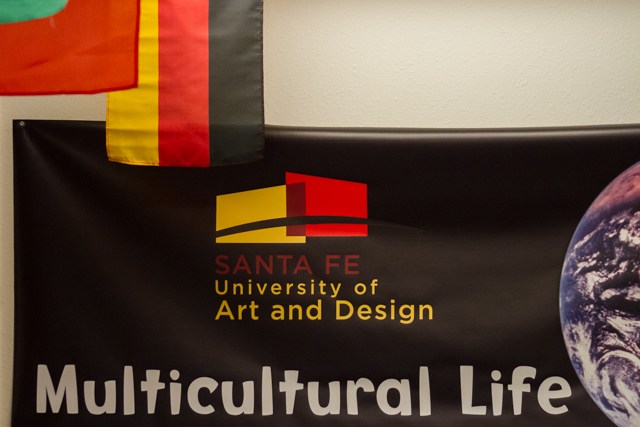
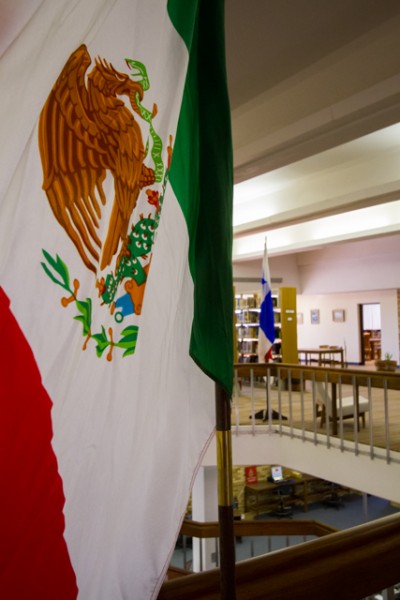
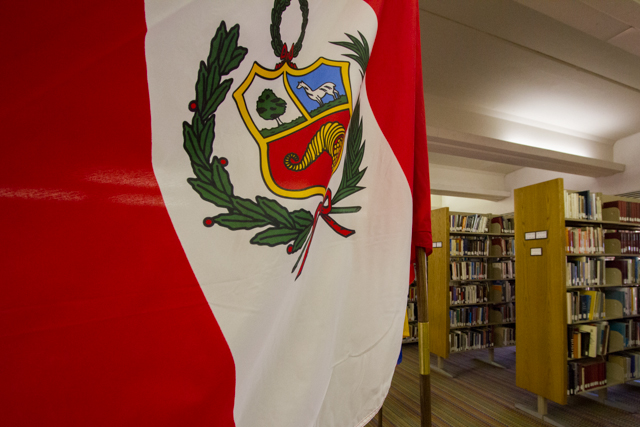

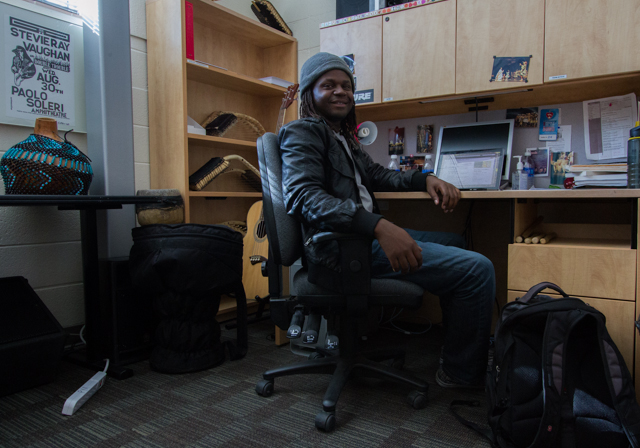
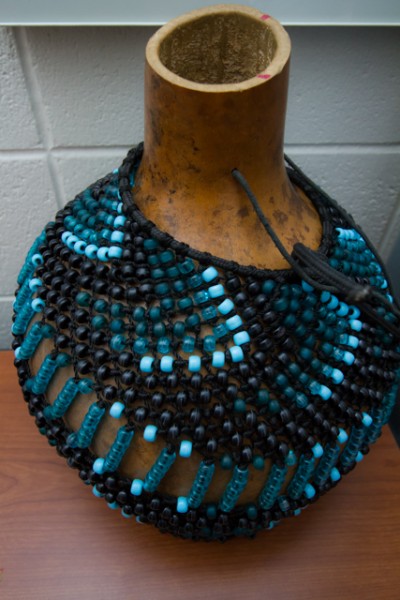
 Jackalope Magazine is the student magazine of Santa Fe University of Art and Design. Building on the interdisciplinary nature of our education, we aim to showcase the talent of our university and character of our city.
Jackalope Magazine is the student magazine of Santa Fe University of Art and Design. Building on the interdisciplinary nature of our education, we aim to showcase the talent of our university and character of our city.